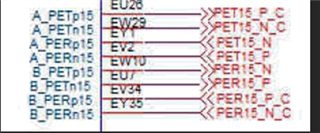Other Parts Discussed in Thread: DS320PR1601-RSC-EVM, DS320PR1601, USB2ANY
Tool/software:
Hi TI Team,
I'm using the DS160PR1601ZDGR PCIe redriver and referring to the DS320PR1601-RSC-EVM schematic. I have some questions:
1.Kindly help to check EVM U1D schematic. PCIE PET or PER signal. Some P is connect to N or N is.connected to P. Is this correct ?

2.The schematic includes many jumpers, but I have limited space for pin headers. What are the default jumper settings, and are all jumpers necessary for operation?
3.The EVM includes a serial EEPROM. Could you provide the EEPROM file for programming, and what is the procedure to program it?
Thanks!

